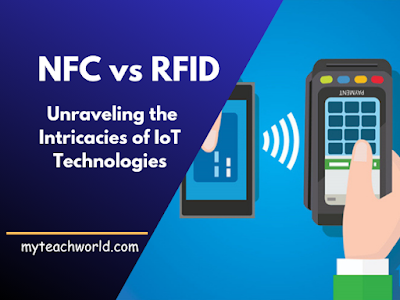NFC (Near Field Communication) and RFID (Radio-Frequency Identification) are two acronyms that stand out prominently in the vast landscape of the Internet of Things (IoT). These technologies are essential to the development of connected devices because they have special features that set them apart. In this article, we will explore the intricacies of NFC and RFID, delving into their distinctions, uses, and the small details that make them indispensable in the IoT.
Understanding the Basics
NFC: More Than Just a Tap
NFC, as the name suggests, involves communication within a close proximity, typically a few centimeters. It facilitates quick and secure data exchange between devices with just a tap. The applications of NFC are widespread, from contactless payments to effortless pairing of devices.
Applications of NFC
Contactless Payments:
Access Control:
RFID: Beyond the Horizon
Contrastingly, RFID operates over longer distances using radio waves. It’s the technology behind the tags on merchandise in stores, enabling seamless inventory management and supply chain tracking. RFID’s reach extends beyond what the eye can see, making it an ideal choice for various industries.
Applications of RFID
Inventory Management:
Asset Tracking:
Unveiling the Differences
| Feature | NFC | RFID |
|---|---|---|
| Communication Range | Close Proximity (few centimeters) | Extended Distances (up to several meters) |
| Power Source | Can be Passive or Active | Often Powered by RFID Reader |
| Data Transfer Speed | Faster | Slower compared to NFC |
Range:
Use Cases:
Power Play: Passive vs. Active
While RFID frequently depends on the power from the RFID reader, giving it a more flexible alternative for some applications, NFC devices can be either passive or active, drawing power from the starting device or having an internal power source.
Data Transfer Speeds: The Need for Speed
When it comes to transferring data, NFC takes the lead with faster speeds compared to RFID. This swiftness makes NFC the preferred choice for scenarios where quick interactions are crucial.
MUST READ:
- Firewall Best Practices: Enhance Network Security Against Cyber Threats
- Homoglyph Attacks Unveiled: Safeguarding Against Deceptive Cyber Threats
- Gmail AI Unleashed: Fortifying Your Inbox Against Spam with Advanced Security
- Protect Your Data: A Definitive Guide to Prevent Cyber Attacks
- Mastering WhatsApp Forensics: Advanced Hacking and Data Recovery Guide
- Unlocking the Power of WiFi Calling: A Comprehensive Guide
- Apple Beeper Mini: Unraveling the Controversy of iMessage Blocked for Android
- ChatGPT-4 Vision: Revolutionizing PC Control with AI Mastery
Applications in the Real World
NFC’s Everyday Impact
Our daily lives are filled with NFC’s short-range communication. From public transportation cards and mobile payments to smart home gadgets, NFC’s seamless connectivity improves convenience.
RFID’s Industrial Footprint
RFID is an indispensable tool for process optimization in a variety of industries, including asset tracking, inventory management, and even healthcare. Its resilience in harsh conditions further enhances its utility.
Addressing Perplexities and Burstiness
With so many applications and technical subtleties, navigating the complex world of NFC and RFID can be confusing. But precisely this complexity is what makes these technologies so versatile—they can easily adapt to a wide range of scenarios. The interplay of proximity and range, passive and active, creates the foundation for an IoT world that sounds harmoniously.
Conclusion: Embracing Diversity in Connectivity
To sum up, the distinction between NFC and RFID goes beyond simple technological differences and illustrates the diversity needed in the IoT ecosystem. Each technology contributes its own advantages to the table, guaranteeing a comprehensive response to the diverse problems that the connected world presents.
FAQs
Q: Can NFC and RFID be used together?
A: Yes, in certain scenarios, these technologies complement each other for enhanced functionality.
Q: Are NFC and RFID secure for transactions?
A: Both technologies employ security measures, but their effectiveness depends on implementation.
Q: Which industries benefit the most from RFID?
A: Industries such as retail, logistics, and healthcare extensively leverage RFID for efficient operations.
Q: Can NFC work without external power?
A: Yes, NFC devices can operate passively, drawing power from the initiating device.
Q: Are there privacy concerns with RFID technology?
A: Privacy concerns exist, but advancements in encryption and security protocols address these issues.

